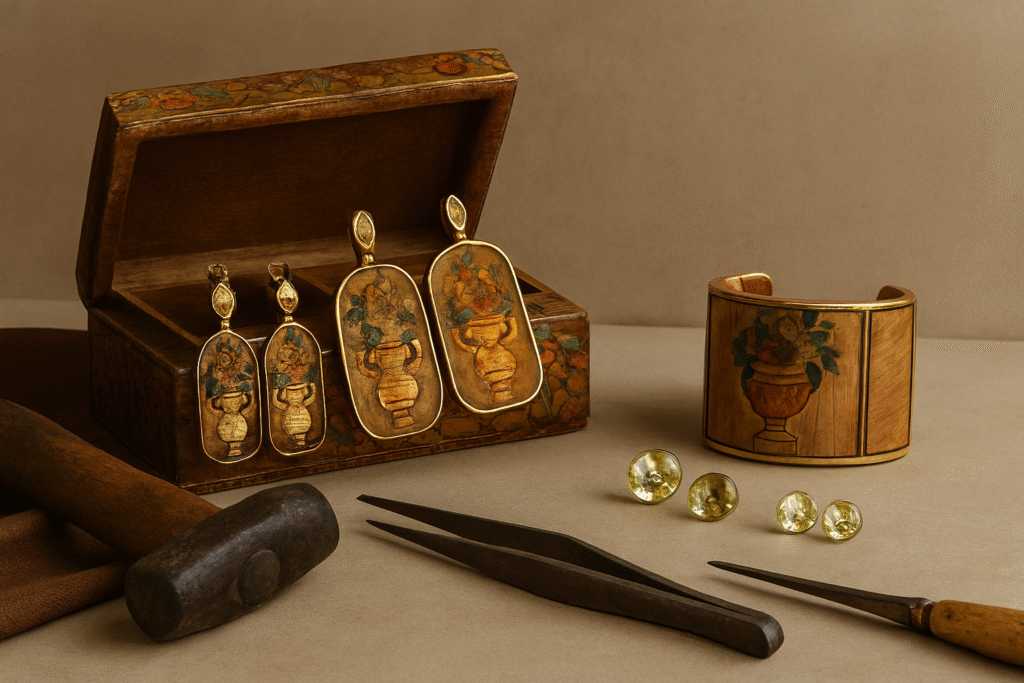Introduction
Journey of a Jeweler by Silvia Furmanovich explores how the Brazilian jeweler collaborates with artisans worldwide to create exceptional jewelry and luxury objects. Instead of focusing only on gemstones, she highlights the importance of traditions that continue to influence her work. Moreover, the book demonstrates how wood marquetry, bamboo weaving, and miniature painting blend seamlessly with gemstones to redefine fine jewelry.
Global Collaborations
Silvia Furmanovich embraces artisan traditions from multiple regions. For example, in India she partners with miniature painters who bring intricate detail to pendants and earrings. Meanwhile, in Japan she adapts bamboo weaving into jewelry, turning everyday techniques into fine design. In Brazil, she works directly with marquetry masters to merge delicate wood inlays with emeralds and diamonds. As a result, her projects show how global heritage finds renewed meaning in luxury design.
Jewelry Beyond Boundaries
The book offers far more than necklaces or rings. In fact, readers also discover handbags, furniture, and home décor crafted with traditional methods. Because these pieces combine creativity with heritage, they appeal to collectors and design enthusiasts alike. Furthermore, research shows that 70% of luxury buyers prefer handmade craftsmanship, which supports Furmanovich’s collaborative approach.
Case Study: Brazil’s Marquetry Legacy
In Brazil, Furmanovich introduces marquetry into high jewelry. She works hand-in-hand with artisans, ensuring their skills reach new audiences. Therefore, the collaboration results in pieces that earned her the Town & Country Jewelry Award. This recognition proves that preserving cultural heritage can also achieve commercial success.
FAQs
Q: What is Journey of a Jeweler about?
A: It’s a book by Silvia Furmanovich showcasing global artisan collaborations in fine jewelry and design.
Q: Why is Silvia Furmanovich important in the jewelry world?
A: She is recognized for blending unconventional materials with precious stones, making her a leader in cultural collaboration.
Q: Does the book only cover jewelry?
A: No, it also explores handbags, furniture, and luxury décor created with artisans worldwide.
For readers interested in jewelry standards, see: Understanding BIS Hallmark in Jewellery.
For advice on buying gold, read: 24K, 22K, 18K: What Every Gold Buyer Must Know.
For travel shoppers, explore: International Jewelry Buying Pitfalls.
Learn more on the official Silvia Furmanovich website.
Read about artisan preservation efforts at the World Crafts Council.
Introduction
This comprehensive Watch Buying Guide answers the most common questions about timepieces.
Whether you’re purchasing your first watch or adding to your collection, these expert insights help you make informed decisions.
From understanding movement types to choosing the right size for your wrist, you’ll find everything needed before making a purchase.
What Types of Watches Should You Consider? – Watch Buying Guide Insights
Understanding the five main categories helps narrow your options:
- Mechanical watches – Use springs and gears. No battery needed.
- Quartz watches – Battery-powered; most accurate.
- Automatic watches – Wind themselves from wrist movement.
- Digital watches – Display time numerically on a screen.
- Smartwatches – Connect to your phone and track fitness data.
Accuracy Expectations – Watch Buying Guide Tips
- Quartz watches – Lose about 15 seconds per month.
- Mechanical watches – Lose 20–40 seconds per day.
- Atomic watches – Lose 1 second every 100 million years.
- Your phone’s clock stays perfectly accurate.
Water Resistance Considerations
Water resistance ratings affect usage scenarios:
- 30m – Handles rain and handwashing
- 50m – Safe for swimming
- 100m – Suitable for snorkeling
- 200m+ – Scuba diving
Replace gaskets every 2–3 years to maintain resistance.
Maintenance Schedule – Watch Buying Guide Advice
- Quartz watches – Battery replacement every 1–3 years.
- Mechanical watches – Full service every 3–5 years.
- Service costs: $200–800 depending on the brand.
Watch for stopping, running fast/slow, or condensation under the crystal.
Pricing Strategy
- Budget watches – Plastic cases, basic movements
- Mid-range watches – Steel cases, reliable mechanisms
- Luxury watches – Precious metals, hand-finished details
Remember: craftsmanship, materials, and brand prestige drive prices.
Sizing Advice
- 6–7 inch wrists – 38–42mm
- 7–8 inch wrists – 40–44mm
- 8+ inch wrists – 42–46mm
Ensure lugs don’t overhang wrist edges.
Complications to Prioritize
- Date display – Useful daily
- GMT hand – Second time zone
- Chronograph – Stopwatch
- Moon phase – Decorative
- Annual calendar – Adjusts month lengths
More complications = more things that can break.
Maintenance Tips
- Clean with a soft cloth
- Avoid extreme temperatures & magnets
- Wind manual watches daily
- Use watch winders for automatics
- Don’t adjust date between 9 PM–3 AM
Investment Potential
- Most watches lose value after purchase
- Only select Rolex, Patek Philippe, Audemars Piguet models appreciate
- Vintage watches from 1960s–70s show strong growth
- Buy watches you enjoy wearing, not solely for investment
Essential Tools
- Spring bar tool
- Case back opener
- Soft polishing cloth
- Watch cushion
- Demagnetizer
Where to Purchase
- Online – Better selection, often cheaper
- Physical stores – Try before buying
- Authorized dealers – Full warranties
- Grey market – Discounts, limited warranty
- Forums/eBay – Vintage pieces, verify authenticity
Learn More:

